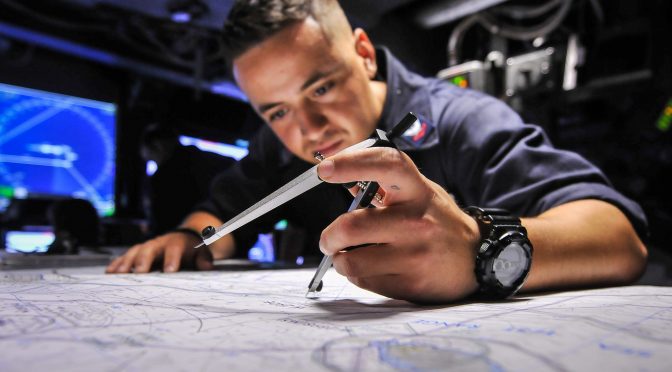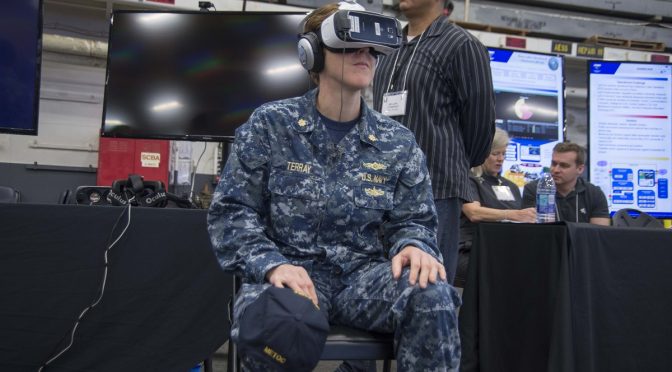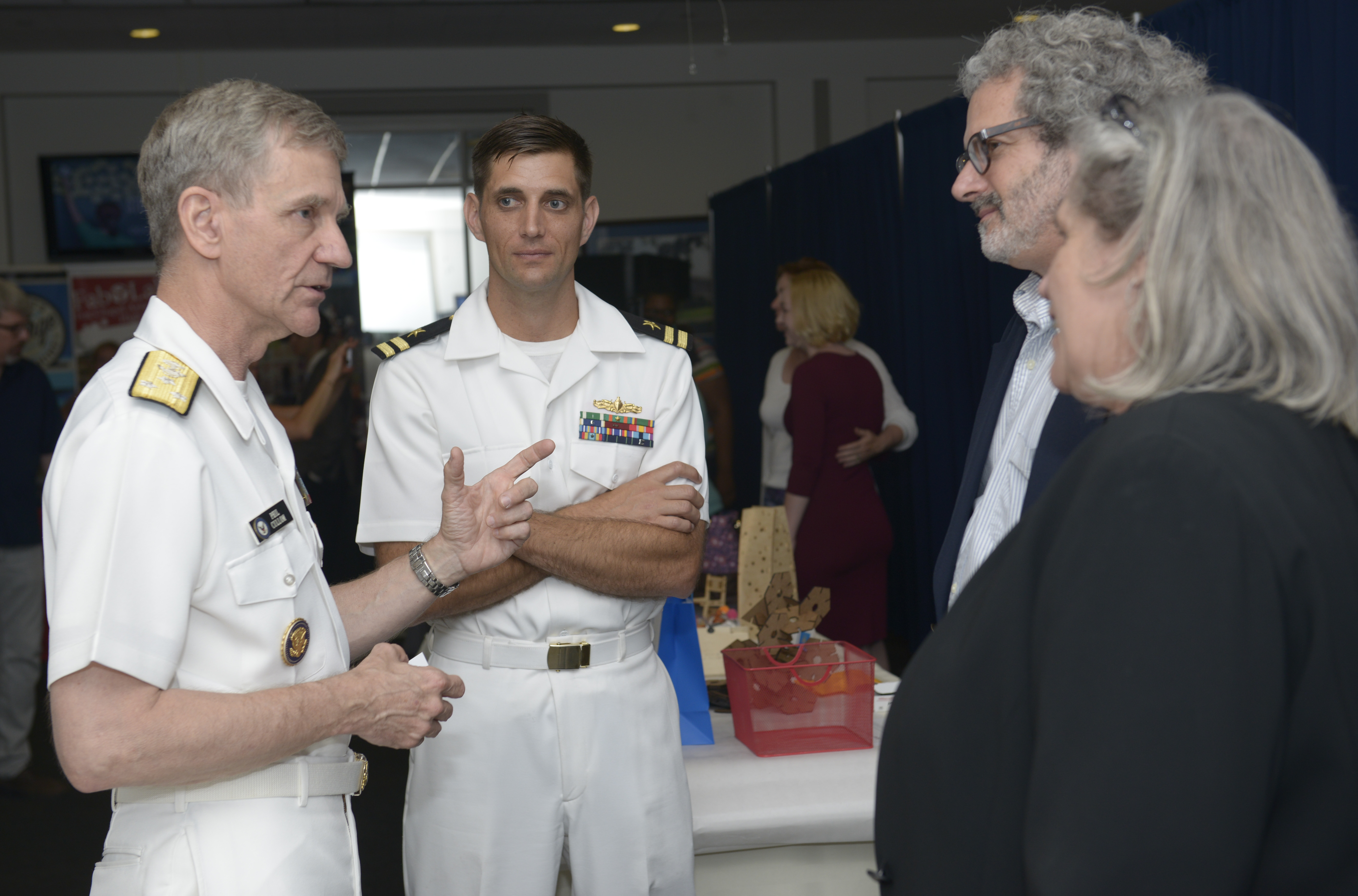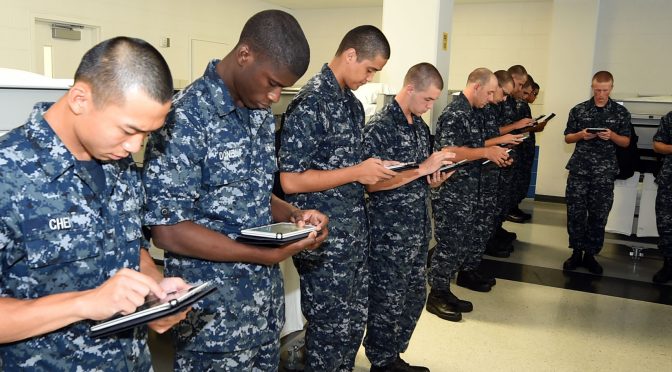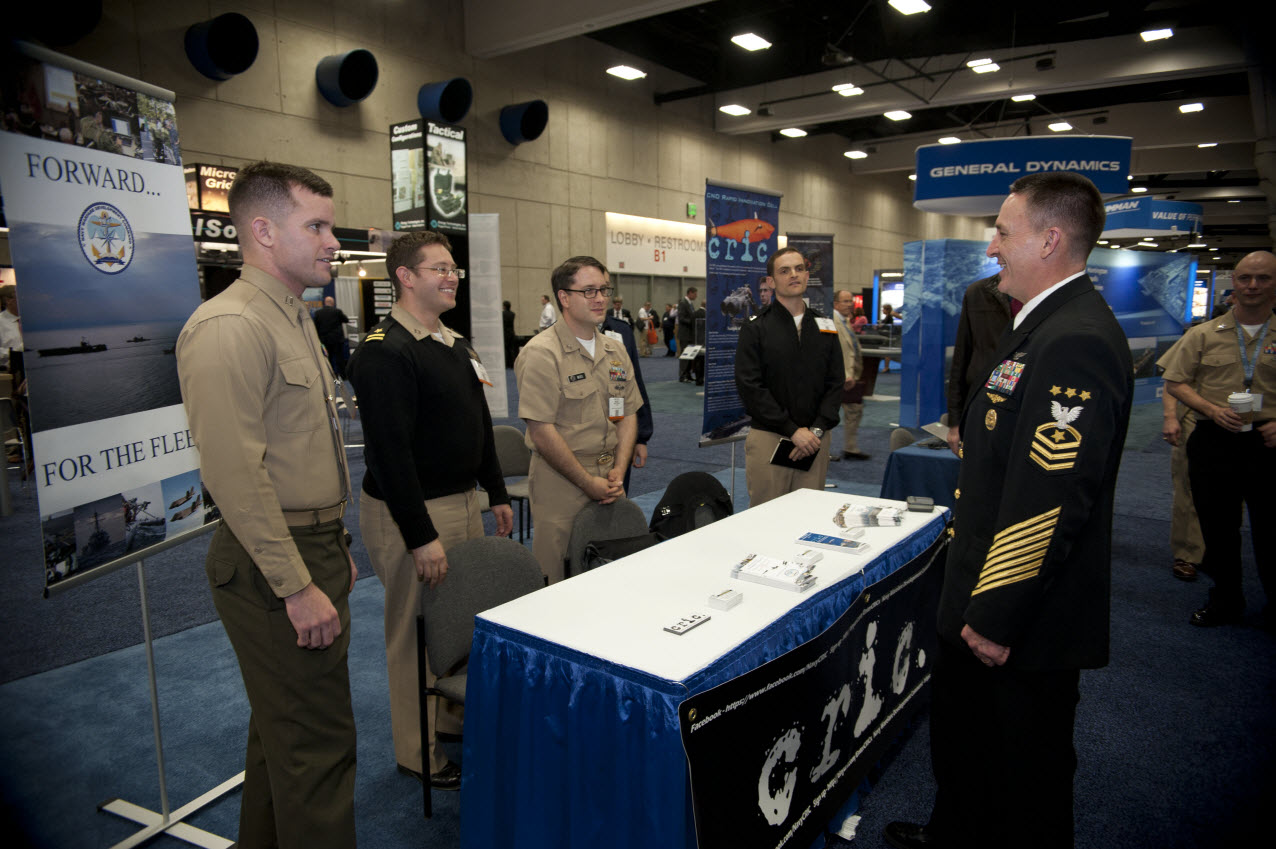By LT Jason Knudson
My challenge to the Fleet, the Navy, and the rest of the Department of Defense is to not just seek out “innovation.” For many reasons, just seeking out innovation is not enough. I challenge the fleet to be “deliberately innovative,” taking deliberate steps to drive innovation and change into the organization.
One way we at the SEVENTH Fleet Innovation Team are accomplishing this is through “Illuminate Thinkshops” presented by Leadership, Equality, and Diversity (LEAD). These workshops were held in conjunction with the U.S. Fleet Forces Green Team at Atsugi, Sasebo, and Yokosuka Naval Bases from January 23 – February 3, 2017.
The Thinkshops reached over 2,000 Sailors, Marines, and Navy civilians stationed in Japan. In addition, Command Triad Thinkshops “illuminated” over 150 command triad members on how to deliberately lead and support a diverse organization of problem solvers. Innovation can not survive without top cover and support of the chiefs and officers in charge of the organization.
The actual key to success of deliberate innovation in SEVENTH Fleet, however, is the creation of the Fleet Innovation Network (FIN). The SEVENTH Fleet FIN is a key node in the SECNAV’s Naval Innovation Network. It is made up of the more than 170 Command Innovation Facilitators we trained through the Illuminate Thinkshops. These Facilitators will be a place potential innovators can to go for guidance, mentorship, and more importantly, to connect with other facilitators in the network.
Below, I will discuss some of the thoughts I had as we organized the Thinkshops and discussed the role of innovation in the Navy and at SEVENTH Fleet.
| For more info on the LEAD Presents: Illuminate Thinkshops, go HERE, HERE, HERE, and HERE. |
Being Deliberately Innovative
“We need to build a culture of innovation into our organization at all levels from the Sailors and Marines on the deckplates to our senior leaders and our civilian workforce. We cannot sit back and simply hope for innovation to happen.” – VADM Joseph Aucoin, Commander, SEVENTH Fleet
Innovation is all around us. This morning, I poured a bowl of innovative cereal. My computer, it’s innovative. The last brief I received on a future military weapons system – innovative. Innovation is an easy buzz term. “My product isn’t just new, it’s innovative!” I hate to break it to my cereal company, but when everything is innovative, nothing is.
The term innovation has been so misused it has started to lose its punch. Innovation has become synonymous with “new.” As many of us can attest, new things are not necessarily good things. I feel frustrated because innovation isn’t just about new things, it is about new things that may bring a strategic advantage. As the Fleet ages one more year, it is increasingly obvious that we need the right new things to replace outdated equipment or we will continue to fall behind potential adversaries. To gain back our strategic advantage, we need to bring real innovation. That means we need to deliberately shape how and, more importantly, who does innovation in the Navy.
Innovation is not just getting the right things. Innovation is also about controlling the processes we use to get the effects we want. We have layers upon layers of regulation, rules, and processes that are out of date, wrong, or just plain inefficient. In order to do what we need to do, at the time of our choosing, we need to control the processes we use. In some cases, this means changing or rewriting our rules. Rules and regulations should aid us instead of standing as barriers. Largely, we should first look at removing the barriers to innovation completely, which means eliminating entire sets of rules and regulations. We own the process; we need to stop acting like the process owns us.
To take back ownership, the Chief of Naval Operations has challenged the Navy in his “Design for Maintaining Maritime Superiority” to implement high velocity learning. The high velocity learning concept was influenced in part by a book by Steven Spear, The High Velocity Edge. High velocity learning is not just about learning faster, but it is about the learning that is associated with becoming an organization that can sustain its advantage over others. Steven Spear calls an organization that is able to continually maintain an edge over its competition a “high velocity organization.” A high velocity Navy will be able to sustain its advantage over potential adversaries.

A high velocity organization is organized and empowered to rapidly identify problems and inefficiencies and fix them. In today’s Navy, eliminating variation often feels like the primary business of the entire organization. In a high velocity organization, when a problem is identified, the entire organization must swarm on the problem and solve it. This often means rapid and dynamic changes to the organization. High velocity organizations are intolerant of workarounds, but are tolerant of failure that helps them improve. In the Navy as it is today, change is minimized and failure is verboten. In a high velocity Navy, change is embraced and failure is a part of the process. Problems are identified and solved by the whole organization.
When the organization identifies problems, the solution is often real innovation – either a technological solution, or a modification to an existing process.
A key aspect of high velocity organizations is they share the solutions they have learned widely and at all levels. When a problem is identified, the organization puts all of its resources behind solving the problem. This is the essential part of high velocity learning. The organization itself must be able to take advantage of all the ideas it is capable of creating, implement them, and share them widely. To do this, it must be deliberate in seeking out inefficiencies, developing innovative solutions, and implementing them.
Innovation doesn’t happen by accident.
The Rub
Why don’t we as an organization embrace high velocity learning and innovation as the drivers of a high velocity organization? That is a complex question, but ultimately, Navy and Department of Defense cultures do not support it. What is it about our culture that prevents the deliberate application of innovation?
The Navy has a Culture of Zero Risk Tolerance
In the late 1980s through the early 2000s, the Navy focused on Total Quality Management and Lean Six Sigma. These management theories sought to eliminate all risk in processes through the implementation of controls and data-driven management. As a result, large organizations were developed to measure, test, and evaluate performance and to mitigate risk. Initially, costs went down as we eliminated waste. Workplace injuries and work defects declined considerably. These were largely successful programs that helped the core business of keeping ships, submarines, and aircraft afloat and maintained.
However, the same risk mitigation processes were hostile to innovation. Innovation, by its nature, will disrupt the status quo. It can be evolutionary, like the spiral development of a weapons system, adding features systematically. Sometimes it is revolutionary, making an entire section of Navy business irrelevant. Implementing an innovation is disruptive to the core business of the Navy, and so, under Total Quality Management and Lean Six Sigma (as practiced by the Navy), innovation is a risk to be mitigated. Failure of a system within the core business is to be avoided, even if the system is out-of-date or inefficient. The system is designed to mitigate all risk to the system, even that risk that is beneficial.
Compare this to a common mantra in the startup culture often associated with Silicon Valley. Silicon Valley businesses are encouraged to: “Fail Early, Fail Often, Fail Cheap, and Learn Always.” This philosophy allows tech businesses to rapidly iterate through successful and unsuccessful trials of new ideas. Businesses mitigate risk by creating minimum viable prototypes and testing them in operationally relevant environments. They further develop successes, and learn from, celebrate, and discard failures.
The Navy needs both systems: one system that mitigates risk in the core business, and another that accepts risk as a part of development. We must be conscious of the risk to our core business of bringing in new innovation, but also be hostile to the core business practices that are maintained simply to mitigate risk. We need to iterate faster than our adversary, and so, we need to build a culture that can appropriately evaluate, accept and celebrate risk.
The Navy has a Culture of Busy-Ness
In April 2016, Major Crispin Burke wrote an article called “No Time, Literally, for All Requirements.” In it, he identified a major issue with training requirements in the Army. He writes, “Fast-forward to 2015, wherein a study at Fort Leavenworth, Kan., revealed a training deficit of 258 days—so nearly 20 months of annual mandatory training crammed into a 12-month calendar year.”
The Navy has a similar problem. Add this to the number and priority of collateral duties required for promotion, as well as command-sponsored fundraising events, mandatory fun events, and community outreach. Then, add boards, qualifications, watch, professional development, and if you’re lucky, family time.
Innovation and process improvement requires time to think, pause, and evaluate if the processes we are using are relevant, efficient, and right. Implementing innovation is disruptive and has a bureaucratic cost to it. It may even have a short-term mission cost. For a watchfloor with limited personnel to implement a major training initiative, it may mean standing down the watch for a little bit of time. The culture of the Navy is biased against stopping operations to implement improvements, even if the improvements will save time overall.
A high velocity organization does not have time to waste on efforts that do not move the organization forward. A high velocity organization is not afraid to stop unnecessary efforts and remove inefficient processes. In business, this is how a high velocity organization stays ahead of the competition. For the military, eliminating bureaucratic bloat and focusing on warfighting effectiveness is how we prevent, and if necessary, fight and win wars.
And so, here again is where deliberate innovation comes in hand. The organization must have the ability to identify wasteful work and eliminate it. It must provide time for thinking, reflecting, and rest. A culture of busy-ness isn’t a sign of a healthy organization. It is a sign of an inefficient one. Innovation must become a priority, because a culture of innovation is the only thing that can overcome a culture of busy-ness. A culture of innovation is a culture with a job to do.
The Navy has a culture that does not adequately support innovators
When we talk about innovation, there is a temptation to make the claim that we should all be innovative. In reality, an organization filled with only innovators is as ineffective as an organization with no innovators. For every innovation, there must also be a group of people able to transition the innovation and sustain it into the core business.
In his 1962 book Diffusion of Innovations, Everett Rogers describes the diffusion of innovation as a bell curve, breaking up the population based on their tendency towards innovation. The first half of the curve includes the Innovators (2.5%), and the Early Adopters (13.5%). The bulk of people fall into the Early Majority (34%) and the Late Majority (34%). The last group is the Laggards (16%).

While there has been no specific study to prove it, we can assume that the distribution in the Navy approximates the general population. Those who may identify, and act as active innovators within the organization will only make up between 2.5%-10% of all individuals. The rest of the group will (and should) focus on the core business aspects of the Navy.
Innovators tend to stray from the status quo. By nature, they break the rules, which is necessary for innovation. When asked by the Marine Corps at the Force Development 25 Innovation Symposium where to find innovators, Chief of Naval Operations’ Rapid Innovation Cell Project Lead and Illuminate Thinkshop creator, AT1 Rich Walsh responded, “First look at those who have been to mast.”
Inevitably, those who challenge the status quo will run into problems in the military. They are a minority within a system that works to minimize variation within the organization. In addition, to gain access to the resources and sponsorship necessary to implement their innovation, they often have to interact at very high levels in the chain of command. This creates risk in the perception that the innovator is skipping the chain of command, especially for junior enlisted personnel.
One of the best analogies to being an innovator within the military is like being an organ in an organ transplant. The innovation organ is necessary for the body to function, but the body identifies it as a foreign body and attacks it with antibodies. Without support and suppression of the antibodies, the organ will very likely be rejected, and probably harmed in the process.
Being an innovator is hazardous work, and so we often see innovators leaving the service early, further diluting the distribution of innovation in the higher ranks.
The solution is to build a culture that is capable of supporting the innovator, while protecting the core body. The difference between an organ transplant and a tumor is purpose and intent, and so an innovator must be given both purpose and intent. This has to occur at all levels of the chain of command.
The Golden Triangle of Innovation
I recommend creating a “golden triangle” in order to drive innovation within an organization. First, you need a young-minded innovator. Innovation holds no age or rank, but is an attitude associated with youth. Innovative minds have a higher propensity to take risk and a greater resiliency to failure.
Second, find a senior mentor or “greybeard.” This person provides top cover for the innovator, advice, and knowledge of the system. In addition, senior mentors are often connected to resourcing for innovation. The senior mentor’s primary job is to protect the innovator from antibodies, and to remove barriers to innovation. The senior mentor also reduces risk to the system as they can properly direct the innovation to minimize disruption to the core business. The senior mentor is often the Commanding Officer of a ship or Flag Officer with access to resources.
Third is the technologist or policy guru. This is the person who can take the idea and put the technological and policy rigor behind it so it can fit into the system. A common mistake made in innovation is to transition the idea from the young-minded innovator and transition it wholly over to the “expert.” Because of the diffusion of innovation, it is very likely that the technologist or policy guru is not an innovator or early adopter. In fact, it may be desirable that the technologist is not an innovator or early adopter. The technologist is the immunosuppressant that ensures the body can accept the innovation.
A high velocity organization isn’t just about innovation, nor is it about the innovator. It is about building an organization that can support innovators and innovation as a driver for the high velocity organization. This requires the entire organization – both innovators and supporters – to be involved. To build a high velocity organization, the entire culture must be positioned to support innovation and innovators.
Casey Dean, an Army Officer, Naval War College Graduate, and a Member of the Defense Entrepreneur’s Forum writes in an article entitled “Not an Innovator, but Still in DEF”:
“If not an innovator, what am I? I am a sponge, a moocher, your lazy brother-in-law. I feed from the energy of DEF. I appreciate the true innovators in the group and I want to take part. I’m a facilitator, attempting to connect the DEF community and its message to a larger audience. I feel like…a Tummler; a Yiddish word originally titled for a person who gets folks to dance at weddings.”
In order for a culture that supports innovation to take off, the Navy needs to develop more Casey Deans. The Navy needs more Tummlers to support our innovators.
Conclusion
Innovation within a bureaucracy as large as the Navy and the greater Department of Defense does not occur spontaneously. It exists behind the scenes. Without a deliberate attempt to bring innovation to the forefront, innovation will continue to occur as the exception to the norm, instead of as a core part of our business.
We cannot address innovation without addressing the Navy culture. It is not enough to wait for other organizations like the Office of Naval Research or the Systems Commands like NAVSEA, NAVAIR, or SPAWAR to deliver innovation to the Fleet. No, the entire Navy, the Fleet, each command, and each individual, must deliberately be aware of innovation as a driver of change. We as a team must set the conditions for the organization to accept and transition innovation, and we must protect innovators as the valuable, low-density resources they are.
We also cannot think of innovation as an island unto itself. We must drive towards being a high velocity organization, following the Chief of Naval Operations’ vision of implementing high velocity learning at all levels. This means identifying ideal processes, being intolerant of inefficiencies and workarounds, swarming to bring forward solutions through innovation, and then sharing the knowledge broadly across the entire enterprise.
This is an all hands effort.
We have to be willing to experiment, be unafraid of failure, and iterate quickly on our results. This is just the first step. Next, we hope to stimulate the Fleet Innovation Network to begin driving their own events, to identify issues in their own commands, solve them, and share them. We will build the Fleet Innovation Network over the next year, and we will highlight our failures as brightly as we do our successes.
This is what being deliberately innovative is. It is a culture of continuous improvement that drives our organization its highest velocity and to achieve its highest potential. We are not there yet, but we are taking the first steps.
LT Jason Knudson is the U.S. Navy’s SEVENTH Fleet Innovation Officer. He is passionate about innovation, design thinking, and the unbridled potential of connected human beings. Contact him at lead.c7f@fe.navy.mil.
Thoughts and ideas are his and do not necessarily represent those of the Department of Defense, Department of the Navy, or SEVENTH Fleet, however he hopes they will. External links are for reference and are not meant to be an endorsement by the above organizations.
Join the conversation at facebook.com/navyleads and on twitter @navyleads.
Featured Image:PACIFIC OCEAN (Sept. 01, 2015) Operations Specialist 2nd Class Taiese Gaono tracks a course on the chart board aboard the amphibious transport dock ship USS New Orleans (LPD 18) during Exercise Dawn Blitz 2015 (DB-15). (U.S. Navy photo by Mass Communications Specialist 3rd Class Brandon Cyr/Released)

